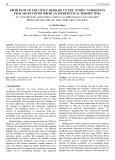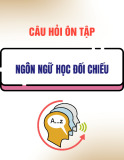
86 Vo Thi Thu Hien
FROM PLOT OF THE LITTLE MERMAID TO THE “STORY” VERSIONS IN
FILM ADAPTATIONS (FROM AN INTERTEXTUAL PERSPECTIVE)
TỪ CỐT TRUYỆN NÀNG TIÊN CÁ ĐẾN CÁC PHIÊN BẢN “CÂU CHUYỆN”
PHIM CHUYỂN THỂ (TỪ GÓC NHÌN LIÊN VĂN BẢN)
Vo Thi Thu Hien*
The University of Danang - University of Science and Education, Vietnam
*Corresponding author: vtthiencv@gmail.com
(Received: March 25, 2025; Revised: April 17, 2025; Accepted: April 18, 2025)
DOI: 10.31130/ud-jst.2025.157
Abstract - Literature and cinema are two art forms that share a
strong and interconnected relationship. This is because they
both originated from earlier forms of artistic expression and in
every film, there are elements of painting, music, and, most
notably, literature. To gain a clearer understanding of this
relationship, the application of intertextual theory to analyze
texts provides a convenient perspective. In this paper, we aim
to clarify the process of literature-to-film adaptation,
specifically focusing on Andersen’s fairy tale The Little
Mermaid and its various film adaptations by Disney, through
the lens of plot. Thus, we seek to demonstrate that intertextual
theory is an open framework, one that is not confined to
literature but can also be applied to the analysis of various other
art forms.
Tóm tắt - Văn học và điện ảnh là hai loại hình nghệ thuật luôn có
mối quan hệ bền chặt và tương quan lẫn nhau. Bởi lẽ, vì là loại
hình nghệ thuật được ra đời từ nền tảng của các loại hình có trước,
trong mỗi bộ phim điều mang dáng dấp của hội họa hay âm nhạc
và đặc biệt nhất là văn học. Để có thể tiếp nhận một cách sáng tỏ
về mối tương quan đó, việc lựa chọn lý thuyết liên văn bản để soi
chiếu văn bản là một góc nhìn khá thuận tiện. Trong khuôn khổ
bài viết, chúng tôi muốn làm rõ quá trình chuyển dịch văn học -
điện ảnh, cụ thể là trường hợp truyện cổ tích Nàng tiên cá của
Andersen và các phiên bản phim chuyển thể của Disney thông
qua khía cạnh cốt truyện. Từ đây, chúng tôi muốn chứng minh
rằng: lý thuyết liên văn bản là một góc nhìn mở, nó không chỉ bị
giới hạn trong khuôn khổ văn chương mà còn có thể áp dụng để
phân tích nhiều loại hình nghệ thuật khác nhau.
Key words - intertextuality; The Little Mermaid; literature-to-
film adaption; plot; Disney’s film.
Từ khóa - Liên văn bản; Nàng tiên cá; chuyển thể văn học - điện
ảnh; cốt truyện; phim của Disney.
1. Introduction
As a “late-born” art form, cinema has always
maintained close connections with pre-existing art forms,
particularly literature. However, accurately perceiving the
relationship between cinema and literature is not a simple
matter, especially when film adaptations of literary works
have traditionally been regarded as derivative products of
secondary importance. Currently, with intertextual theory,
the concept of adaptation has undergone significant
changes. The adaptation process is now viewed as a
process of (re)signification or (re)creation from pre-
existing material to establish a new artistic code system,
facilitating code transformation and interaction between
the two art forms of literature and cinema.
Intertextuality is a theory proposed in the late 1960s by
Bulgarian critic Julia Kristeva. “Every text is an intertext”
- Kristeva developed this theory based on the philosophical
foundations of Ferdinand de Saussure and Mikhail
Bakhtin. They established the semantic nature of language
and the potential for expanding word meanings in their
numerous studies, asserting that language never exists
independently but always reflects and parallels human
culture and customs. Therefore, every sentence, word, and
utterance in the present inherently contains shadows of
what came before, whether the subject intends this or not.
Intertextual research examines the correlations between the
subject and its surrounding elements. This approach
involves reading a text through the lens of other texts,
thereby illuminating the resonance of ideas and aesthetic
qualities within the text, while simultaneously enabling
parallel reading to discover similarities and differences
between texts [1]. In Vietnam, since the late 20th century,
Hoang Trinh has garnered critical acclaim in the field of
literary criticism with his seminal work “From Semiotics
to Poetics”. This contribution earned him the first Ho Chi
Minh Prize in 1995 [2]. In 2019, Nguyen Van Thuan
published the textbook “Intertextuality Theory” [1]
Additionally, regarding the issue of literary-to-cinematic
adaptation from the perspective of intertextual theory, we
recognize “Literary-Cinematic Adaptation: An Intertextual
Study” by Le Thi Duong as a representative scholarly work
in the field [3].
Building upon studies applying intertextual reading to
decode literary works and their cinematic adaptations, we
are particularly interested in Disney's ongoing trend of
remaking classic animated films into live-action versions,
such as Aladdin (2019), The Lion King (2019), Mulan
(2020), Pinocchio (2022), and The Little Mermaid (2023).
Hans Christian Andersen's fairy tale “The Little Mermaid”
has arguably been an essential part of childhood for
millions of children worldwide. As an animation studio
that frequently draws material from fairy tales, Disney has
granted The Little Mermaid a significant position with two
adapted films (the animated version in 1989 and the live-






















